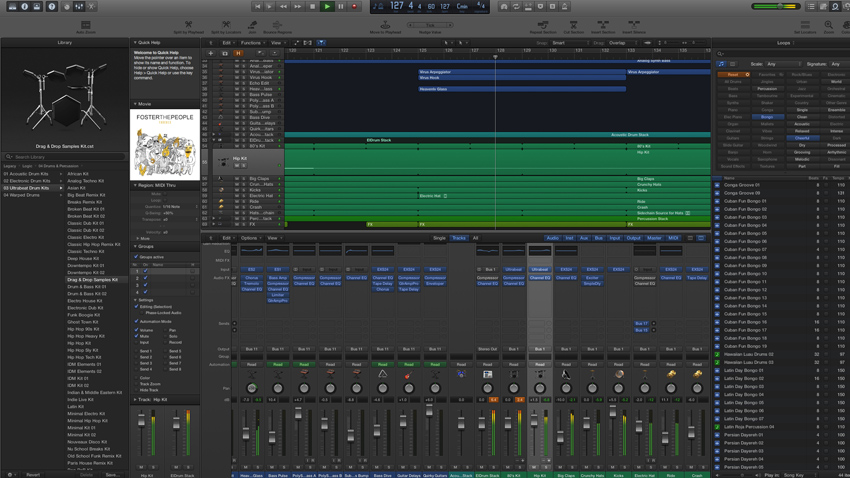MusicRadar Verdict
X marks the sweet spot for Logic Pro, being accessible enough not to offend GarageBand graduates while pulling enough new tricks to keep the faithful satisfied without compromising its heritage in the process.
Pros
- +
Drummer is amazing. Flex Pitch works well and sounds good. Excellent MIDI Effects. Gorgeous new interface. Brilliant iPad controller app. Nothing broken or taken away.
Cons
- -
Toolbar is a pain on smaller screens. Effects and instruments are looking tired. The odd graphical glitch and minor bugs.
MusicRadar's got your back

Apple Logic Pro X

Apple Logic Pro X Drummer

Apple Logic Pro X Drummer Producer Kit

Apple Logic Pro X Drum Kit Designer.

Apple Logic Pro X Bass Amp Designer

Apple Logic Pro X Flex Pitch.

Apple Logic Pro X MIDI effects

Apple Logic Pro X new instruments

Apple Logic Pro X Smart Controls

Apple Logic Pro X Folder Stack

Apple Logic Pro X Summing Stack

Apple Logic Pro X Apple Remote
The first thing that existing Logic Pro 9 users need to know about Logic Pro X is that nothing has been taken out of Apple's revered DAW in order to make the transition to its tenth full version. All of your Logic Pro 9 projects (and earlier) will still open in it, and everything you've always known and loved about Logic is still here -the Environment, the Transform Editor and the Hyper Editor (now, understandably, renamed Step Editor). So relax - Apple hasn't broken Logic.
The only problem anyone might have in stepping up (apart from griping about the lack of an upgrade path from v9) is that Logic Pro X drops support for 32-bit plugins. The vast majority of Audio Units plugins made the move to 64-bit ages ago, but it is possible that one or two of yours might still be stuck in the past.
However, Logic Pro 9 and X can coexist quite happily on the same Mac, sharing their content libraries and even running at the same time, so you can at least go back to old projects in 9 as needed during your switchover period.
Available only on the App Store and requiring OS X 10.8, Logic Pro X installs with only a minimal library (2GB or thereabouts) to start with, then automatically downloads another 30+GB of Library content when first launched, the vast majority of which is sample content for Drum Kit Designer, which we'll come to shortly.
"Relax - Apple hasn't broken Logic."
You don't have to install everything, of course, but we were quite flabbergasted to see that there's still no option to install the Library on an external drive without manually creating a symbolic link - not something the average user is going to know how to do.
Our irritation at that, though, was countered by an unexpected improvement in the performance of the notoriously crash-happy AuValTool - Logic's validation system for plugins. On first launch, it cheerfully and quickly went through our entire (and enormous) collection of instruments and effects without so much as a hiccup, passing every single one. It's the little things…
The new look
As we all knew it would, Logic Pro X has indeed gone through a Final Cut Pro X style redesign, but unlike that pro video fiasco, this time Apple has done it right.
With its cool, dark background and embiggened icons, controls and legending, it's clearly doing everything it can to make those transitioning from GarageBand feel at home. And it looks all the better for it, the colour scheme classy and gorgeous in the low light of the studio.
There are too many tweaks and improvements to the UI to list, but chief among them is that the Piano Roll now hosts controls for quantise, swing and more, and the Score Editor has been completely redesigned to be more usable. The Transport is now at the top rather than the bottom, and the main menus are reworked to be more logical, moving lots of previously scattered functions into the new Record, Mix and Navigate menus, for example, and repositioning the Track menu in the main menu bar, rather than the Arrange page.
The Library has been moved from the right-hand side of the interface to the left and tarted up with pictures for everything, while volume and pan controls can now be accessed directly in the Track List - thanks, GarageBand.
"Despite Apple righteously waging war on skeumorphism in iOS 7, not only are all the faux 'vintage' instrument and pedal interfaces still onboard, but they've been joined by similarly 'realistic' fader caps and rotaries in the mixer."
The tabbed pane on the right still plays host to the previous Loops and media Browser pages, but now also includes the multi-tabbed List Editors page and Note Pads, which enables note taking for individual tracks (reflecting the channel strip Note areas) as well as the whole project.
The mixer has become a lot easier to use. Effects are re-orderable without requiring a modifier key (frikkin' yay!), plugin slots now reveal bypass, edit and preset selector buttons when the mouse pointer is hovered over them, and gain reduction meters appear on tracks with Logic's own compressors and limiters inserted (also a new feature in Pro Tools 11, fact fans).
However, despite Apple righteously waging war on skeumorphism in iOS 7, not only are all the faux 'vintage' instrument and pedal interfaces still onboard, but they've been joined by similarly 'realistic' fader caps and rotaries in the mixer. Sigh.
Conversely, Logic's venerable collection of pre-Apple synths and effects plugins look a bit weird and overwrought in the context of the slick new interface. We're surprised yet not at all surprised to see that nothing's been done in that department at all - it definitely needs to be, though.
The upshot of all this is that Logic Pro X is immediately more intuitive than 9, much easier on the eye, and just… prettier and more 'designed'.
It's not all gravy, though. The spatial inflexibility of the Toolbar will wind up those using smaller displays. Previously we could fit a ton of buttons into it and hide text or icons to shrink the whole thing down, but now we're stuck with a very thick bar containing a customisable set of oversized buttons that MacBook users will only be able to fit about 13-odd of on before the overflow menu at the right-hand end comes into play, with no resizing options whatsoever. Still, at least it can be killed.
"Logic Pro X is immediately more intuitive than 9, much easier on the eye, and just… prettier."
Track icons, meanwhile, comprise the same nicely drawn but faintly tedious collection of acoustic and electric instruments, and per-pane brightness controls would be welcome, particularly since dark notes on the Piano Roll can get quite hard to see.
All that aside, after an hour or so in X, going back to 9 feels like returning to something from the Atari era - whether or not you see that as a bad thing!
Drummer and Drum Kit Designer
The Logic Pro X feature people seem to be talking about more than any other is Drummer, a virtual tub-thumper integrated so deeply into the app as to have its own Track class. And a Drummer is nothing without drums, so it's accompanied by Drum Kit Designer, a customisable drum kit construction, er… kit.
A team of "some of the industry's best session drummers and recording engineers" (including Bob Clearmountain, no less) were drafted in to put it all together, and the results are pretty amazing.
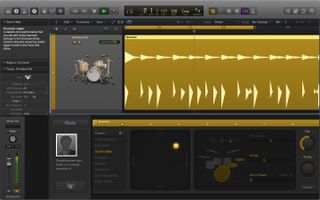
You start by choosing your Drummer from a list of 15 spread across four genres (Rock, Alternative, Songwriter and R&B… cringe), each of which comes with a mildly toe-curling but actually quite authentic description ("Although worried that his music school training will ruin his street cred, Gavin plays complex indie-rock beats on a gritty-sounding kit").
Every drummer has his/her own playing style, which you can tweak and adjust using a small bank of controls or by choosing a preset configuration thereof. The sliders switch between pattern variations for each kit element (comprising kick/snare, hi-hats, cymbals, toms and percussion, not all of which can be active at once), while the knobs control things like the number and length of fills, push/pull, swing and ghost note volume.
"Drummer is by far the best bundled 'live' drum production setup ever included with a DAW."
As to why three of the five knobs are hidden in a separate Details screen, we can only assume, given that the whole Drummer interface looks like an iPad app, that there are plans to integrate it into Logic Remote (see below) at some point.
An X/Y controller pad maps the complexity and playing strength of the pattern, so by moving the puck around you can position the performance anywhere between Soft/Loud and Simple/Complex. The current region updates its strange triangular note markers in real time to reflect all these changes, and while you can only make changes to a Drummer track region using the controls in the Drummer interface, it can of course be converted to MIDI for full editing.
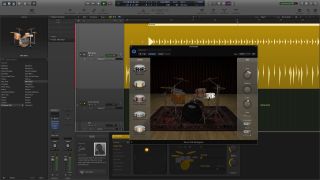
Drummer's performances are astonishingly lifelike and represent its (limited) range of genres very well. Even odd time signatures (5/4, 7/4, 6/8, etc) are handled with aplomb. The15 kits themselves (weighing in at 20GB in total) sound great, and with Drum Kit Designer enabling mixing and matching of a broad range of drums and cymbals, plus the inclusion of fully mixable multichannel Producer Kit Stacks, complete with overhead and room mics, it all adds up to by far the best bundled 'live' drum production setup ever included with a DAW. It's all hugely impressive and will more than satisfy the songwriter or drummer-less producer looking to get some real percussive feel into their tracks.
For some, though, Drummer will be at its most rewarding when pointed at more interesting sound sources than the relentlessly acoustic ones provided by Apple. We had an absolute riot running it through Battery 4, Microtonic, Tremor and the like.
Smart Controls
The equivalent of the macro systems found in other DAWs, Smart Controls enable you to assign up to 12 parameters of your choice from the selected track's channel strip, instruments and effects (both third-party and Logic's own) to a set of MIDI-assignable knobs, sliders and switches wrapped up in a simple GUI housed in the bottom pane.

Assignments can be made 'intelligently' by the software or manually; each control can be assigned to multiple parameters,; response curves are fully editable; and all Smart Controls are automatable. You can also choose from an array of GUI layouts designed to look like real-world instrument/outboard panels - veritable skeumorphic hell,but quite fun, nonetheless.
As a decidedly 'Apple' take on the macro concept, Smart Controls are a resounding success, giving us a clutter-free way to keep key channel and plugin parameters constantly present and instantly accessible.
Stacks
Making the processes of foldering and bussing tracks easier than ever before, multiple tracks can now be nested into fold-away Stacks, of which there are two types: Summing and Folder.
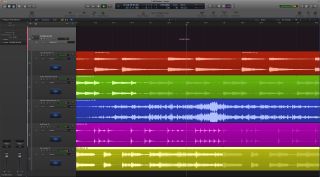
A Folder Stack simply groups the included tracks for unified level control, solo and mute, without affecting their routing in the mixer - like the old Folder Tracks, basically, although they're still around, too, should you prefer.
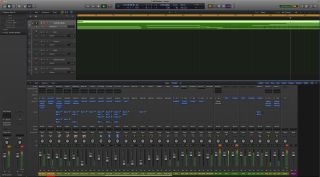
A Summing Stack, on the other hand, mixes the output of all contained tracks to a bus, and can record and play back MIDI on its Master track for triggering all MIDI instruments in the Stack - massive collapsible synth stacks ahoy, then. Stacks can also be made within Stacks, and complete Summing Stacks, with all their components and settings, can be saved into the Library as Patches (a new format for Logic Pro X) for recall at any time.
Stacks are similar to Ableton Live's Groups and Instrument Racks, but once again, Apple has done a great job of realising the concept in its own style. Whether you just want to gather that string section together in the Arrange page or build the world's phattest multi-synth pad, you'll have a much easier and more manageable time of it now than in previous versions of Logic, not to mention most other DAWs.
Flex Pitch
Another of Logic Pro X's headline features, Flex Pitch, expands on Logic Pro 9's excellent Flex Time to enable pitch and formant adjustment of monophonic audio clips. The presentation is superb, with the notes of the selected clip overlaid in a piano roll on top of the waveform, each note graphically indicating deviation from perfect pitch and accompanied by expression lines showing vibrato and pitch movement.
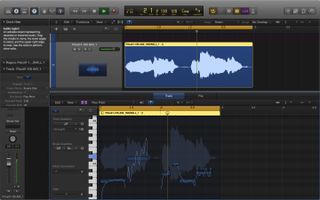
All of the involved parameters - Pitch, Drift, Formant, Vibrato and Gain -are accessed via a set of handles on each note that you just drag up and down to adjust. It's hard to imagine a more intuitive system, and even absolute beginners will have no trouble getting to grips with it.
It also sounds very good indeed - as long as you don't stray too far from the original pitch - and while it doesn't have the toolset to rival Melodyne, it certainly gets the job done. Crucially, being so easily tweakable, sound designers will have a field day with it. You can also export the resulting note sequence to a MIDI track, just like Live's Audio to MIDI Melody function.
MIDI effects
Although the Environment has always made it possible to build MIDI processing devices within Logic, finally we now have proper MIDI Effects plugins with which to beef up and contort our notes and CCs. The headline is the well-equipped Arpeggiator, which features all the functions and parameters you'd expect from such a thing, plus both Live and Grid modes for two different styles of triggering.
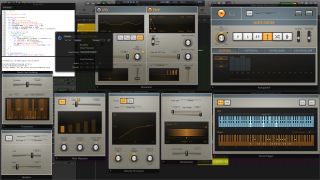
The rest of the line-up includes the self-explanatory likes of Chord Trigger, Note Repeater, Modulator and Randomizer, as well as Scripter, with which you can design your own (in code, I hasten to add - this is absolutely not 'Max For Logic').
Every one's a winner, and we look forward to seeing how this new aspect of Logic develops moving forward, as they say. And with their big, chunky GUIs, like Drummer, Logic's MIDI Effects look very much like they were designed with the iPad in mind. Intriguing.
New effects
After the addition of Amp Designer for guitar processing in Logic Pro 9, X introduces the equivalent for bass. Bass Amp Designer boasts three amps, six cabs and three positionable mics, plus a mix control for setting the balance between amped and DI signals - nice touch!
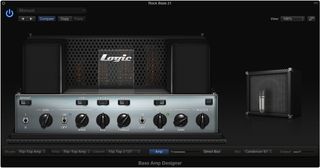
Also on the guitar front, seven new stompboxes have been added to Pedalboard, including a graphic EQ, an octaver and a flanger.
While it would be good to see Apple put a tenth as much effort into catering for electronic musicians as they do guitarists and songwriters, synthesists are at least thrown a small bone with Retro Synth, a decent sounding but basic virtual analogue/FM/waveshaping instrument. Oh, and the modelled EVB3 organ, EVP88 electric piano and EVD6 clavinet have been made over, improved and renamed, and sound as lovely as ever - lovelier, even!
Painfully notable, however, is the total lack of love given to EXS24, which remains the powerful but weird, awkward creature it's always been.
Logic Remote
Free on the App Store, Logic Remote is Apple's iPad MIDI controller app for Logic Pro X, and although it feels like the start of something big rather than a fully realised vision at this point, it's still absolutely fantastic.
Connecting with Logic via Wi-Fi, it gives you direct control of the transport, mixer and Smart Controls for the selected track, as well as enabling note input via multitouch keyboard, guitar, drum pads/kit or GarageBand-style Chord Strips, complete with Scale Mode. You can also create tracks, trigger key commands, load Patches from the Library and even run the Smart Help system (Logic's version of Live's contextual help pane), instantly updating on your iPad to describe whatever's under the mouse pointer in Logic.
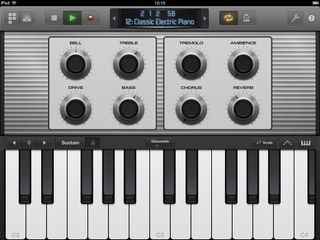
There's still an awful lot Remote can't do that it obviously should, however. It doesn't give you any visual representation at all of the arrangement view (even though it does let you shuttle the playhead using a timeline ruler or the transport display), and, as mentioned, the obviously iPad-influenced Drummer and MIDI Effects are represented by the same Smart Controls as everything else.
And is there any reason why Logic's own plugins couldn't be mirrored 1:1 on the iPad? Even so, it's an awesome app - and, it's worth saying again, it's free.
Conclusion
So, that's the meat of Logic Pro X, but there are lots of 'lesser' features, too, each doing its bit to improve the overall Logic experience. Arrangement and Groove Tracks, sharing to SoundCloud and the Mac media browser, the ability to save projects to self-contained Packages or old-school Folders, the aforementioned Live-style rollover Quick Help system…
Drawing on GarageBand to just the right extent and being unafraid to take inspiration from the competition (Ableton Live, mainly), X marks something of a 'reset' for the Logic Pro series -and one that was unquestionably overdue. Apple has consolidated and refined just about every significant pre-existing feature without unhinging any of them, then added to them with a number of welcome new ones that feel instantly at home.
"X marks something of a 'reset' for the Logic Pro series -and one that was unquestionably overdue."
Drummer (which we weren't sure we'd like, but really do) is wicked; Stacks are a delight; Flex Pitch fills the pitch correction pot nicely; the MIDI Effects hit all the right buttons; and the new interface (for all its skeumorphism) is beautiful.
As mentioned, the Toolbar is a pain, the older effects and instruments desperately need some attention, Apple's resolutely 'Californian' attitude to genres and instrumentation is getting tiresome, and Logic Remote clearly has much more to come.
But none of that significantly detracts from what is ultimately a truly remarkable application. Confidently pushing the envelope in terms of workflow and UI without compromising its rich heritage in any way, Logic has returned from the wilderness to rightly reclaim its throne as the king of DAWs. Welcome back.
Computer Music magazine will be bringing you their own review of Logic Pro X in their next issue (CM195), followed by an in-depth guide to the software in the issue after that (CM196). In the meantime, check out their video overview of Logic Pro X's new features.
Video contents
- Intro - 0:00
- The new interface - 0:47
- Track Stacks - 3:22
- Smart Controls - 6:35
- Drummer & Drum Kit Designer - 9:56
- The new plugins - 17:06
- Flex Pitch - 21:20
- Groove Tracks - 24:50
- Outro - 27:12
Most Popular









